|
|
|
| My Favourite Planet > English > Middle East > Turkey > Ephesus |
| Ephesus, Turkey |
Sightseeing in Ephesus |
|
 |
page 4 |
 |
|
| |

The lower entrance to the Ephesus Archaeological Site. The ticket booth is to the left of the turnstiles. |
| |
|
Ephesus
sights |
Ephesus Archaeological Site |
|
 |
|
Ephesus Archaeological Site
The site is large and fascinating, and is one of the best preserved and restored cities of the ancient Graeco-Roman world. It is also one of the most popular tourist attactions in Turkey, and is often very crowded, especially with tour busloads of Christian "pilgrims", cruise ship passengers and regular tour groups.
See our Ephesus photo gallery.
The increased admission charge of 30 Lira seems quite excessive, and makes visiting the sights of Ephesus and Selçuk an expensive proposition (see Museum Boom part 1: Ephesus at The Cheshire Cat Blog).
There are two entrances to the site: the upper (southeast) and lower (northwest) entrances.
The lower entrance
The lower entrance is the most used and easier to reach from Selçuk or Kuşadası (see page 5: getting there). Most dolmus minibuses and tour buses stop here. There are restaurants, souvenir shops, toilets (see below), a large car/bus park and a post office (PTT) bank with ATMs at the entrance to the site.
The upper entrance
The upper entrance, on the other hand makes more sense for a visitor: it is a downhill walk from the Upper Agora and official part of the ancient city, to the most impressive monumental ruins of the Library of Celsus, the Terrace House and the Great Theatre. There are restaurants, souvenir shops and toilets outside the site, and a museum shop just inside the entrance. Parking space is limited, particularly for large vehicles.
See futher details and photos
on Ephesus gallery page 3.
Open every day
Summer (April-October): 08:30 - 19:00
Winter (November-March) 08:00 - 17:00
Admission charge: 30 TL
Audio guide rental: 15 TL
Languages: Arabic, English, French, German,
Italian, Japanese, Russian, Spanish, Turkish
Car park charges (car park at lower entrance):
bus 40 TL
midibus / minibus 25 TL
taxi / private car 8 TL |
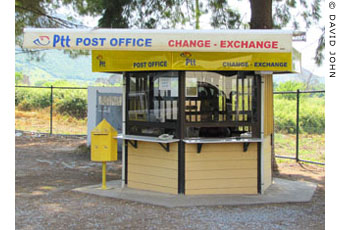
The PTT post office and currency exchange kiosk
outside the lower entrance to the Ephesus
Archaeological Site. |
| |

Audio guide advertisement at
the Ephesus Archaeological Site. |
| |
| |
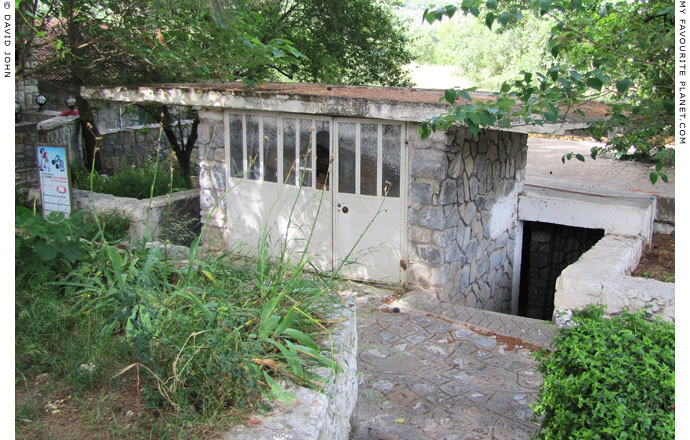
The toilets just inside the lower entrance to the Ephesus archaeological site.
Despite the high 30 Lira entrance charge to the site and the estimated 1 million
visitors a year, the toilets are clean but quite old fashioned, and at the bottom
of steep stone stairways, which are hardly accessible for disabled people. |
| |
Ephesus
sights |
Ephesus - The Terrace Houses |
|
 |
|
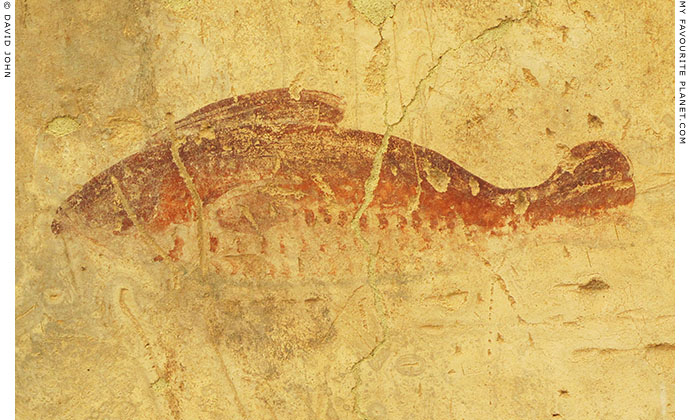
Fish fresco in the Terrace Houses, Ephesus. Roman Imperial period.
|
| The Terrace Houses, Ephesus
A cluster of peristyle, two-storey houses of wealthy families, built in terraces on the lower slopes of Mount Koressos (Bülbül Daği, Nightingale Mountain), at the lower end of Kuretes Street. The richly appointed homes are decorated with floor mosaics, marble wall panels and frescoes. The remains are reminiscent of the ruins of houses in Pompeii and Herculaneum.
The recently restored Terrace Houses are within the Ephesus Archaeological Site, but are privately run, and a separate ticket must be bought. Considering that the admission price to Ephesus has been increased (see above), it may seem a bit steep to have to buy yet another ticket. However, if you can afford it, this is definitely worth seeing.
The Houses have been set up as a covered museum-type space with metal walkways and stairs around and above the the restored rooms, courtyards and streets. This may make access difficult for disabled people. Ask at the entrance.
Open every day
Summer (April-October): 08:30 - 19:00
Winter (November-March) 08:00 - 17:00
Admission charge: 15 TL
Tickets on sale at the entrance to the Terraced Houses,
not at the entrance to the Archaeological Site. |
|
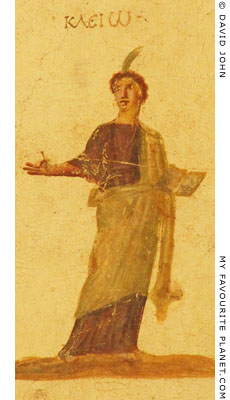
Fresco of the muse Cleo in
the Terrace Houses, Ephesus.
Roman period. |
|
| |
Ephesus
sights |
The Cave of the Seven Sleepers |
|
 |
|

A road sign pointing the way to the Cave of the Seven Sleepers.
|
The Cave of the Seven Sleepers (Also known as the Grotto of the Seven Sleepers; Turkish, Yedi Uyuyanlar), a 3rd century AD necropolis (cemetery), consisting of arched stone and brick tomb niches built in a cleft at the foot of the northeast slope of Mount Pion (Panayır Daği), 1.5 km east of the lower entrance of the Ephesus Archaeological Site, and 3 km southwest of Selçuk.
It is one of several places in the Middle East associated with legends of "the Seven Sleepers". "The Seven Sleepers of Ephesus" were seven young Christians who hid inside the cave around 250 AD to escape a persecution by the Roman Emperor Decius (249-251 AD). They fell asleep there and awoke 180 years later, during the reign of the Christian Emperor Theodosius II, then died shortly after.
A cult of the Seven Sleepers was established in the mid 5th century AD, a church was built here and the complex was expanded several times. The site attracted Christian pilgrims until some time in the Middle Ages.
The site has not been restored, is fenced off and is often flooded by rainwater between late Autumn and Spring. However, the tombs (what little remains of them) and a few large stone sarcophagi can be seen from beyond the fence. What can not be seen are the remains of the frescoes which decorate some of the tomb niches. It is all a bit eery, and a little disappointing. Not the most interesting site, especially if time is limited.
On the other hand the walk from the Ephesus Archaeological Site or Selçuk is through pleasant countryside. Tea and food are served in a relaxed, oriental atmosphere in open tents near the site. There are also, inevitably, stalls selling souvenirs.
Drivers should try to find a place to park at the side of the road without blocking traffic. Sometimes the local people will help you find a parking space.
Open every day
Summer (April-October): 08:00 - 19:00
Winter (November-March) 08:30 - 18:00
Admission FREE (visible through a fence!) |
|
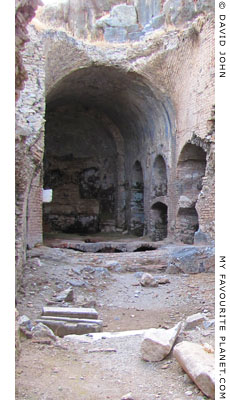
One of the larger burial chambers
at the site of the Cave of the
Seven Sleepers, with niches built
into the walls to hold tombs.
See a plan of the cave complex
on gallery page 1. |
|
| |
Ephesus
sights |
House of the Virgin Mary |
|
 |
|
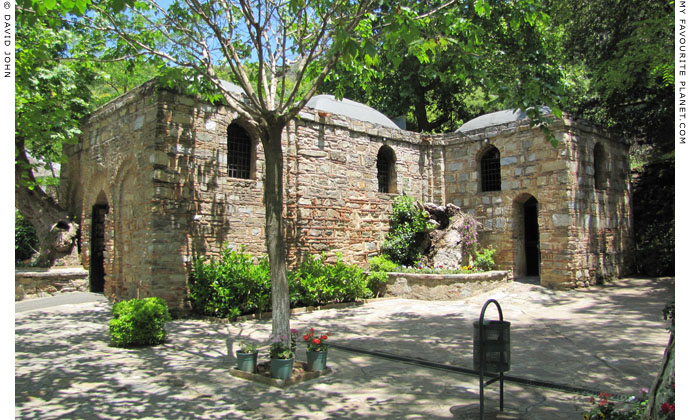
The House of the Virgin Mary (Meryemana), Ephesus.
|
The House of the Virgin Mary (Turkish, Meryemana, Mother Mary's House), a Roman Catholic and Muslim shrine, on Mount Koressos (Bülbül Daği, Nightingale Mountain), 6 km southwest of Ephesus, 9 km from Selçuk.
According to legend, the Virgin Mary came to Ephesus from Israel with Saint John and spent her last years in this house. There is no evidence that the Virgin Mary was ever here, but it has become an official shrine for several Christian denominations, including the Roman Catholic Church. It is often crowded with pilgrims, and is really only of interest to the faithful and those curious about such religious phenomena.
There are restaurants, souvenir shops, toilets, a large car/bus park and a post office (PTT) bank with ATMs at the entrance to the site.
If you do not have a vehicle, you can either take a bus tour or a taxi from Selçuk (30 TL).
See Dolmuş to Meryemena? in our guide to Selçuk.
Open every day
Summer (April-October): 08:00 - 19:00
Winter (November-March) 08:30 - 18:00
Admission charge: 15 TL
There is also a 25 TL charge for vehicles!
A sign at the entrance informs visitors that all the ticket money is taken by the Selçuk municipality, and requests donations for the upkeep of the place. See Ionian Spring part 1 at The Cheshire Cat Blog. |
|

Gilded statue of the Virgin Mary
on the side of the road between
Ephesus and the House of the
Virgin Mary (Meryemana). |
|
| |
Ephesus
sights |
Ephesus Archaeological Museum, Selçuk |
|
 |
|
See further information about the Ephesus Museum
on Sightseeing in Selçuk and Selçuk gallery 2.
The major renovation and expansion work on the museum has finally been completed (see Museum Boom part 1 at The Cheshire Cat Blog), and it was reopened in 2015.
The enlarged museum now has five times as many exhibits as before the renovation,
with over 3,000 artifacts never before on display.
Ephesus Archaeological Museum
(Turkish, Efes Müzesi)
Atatürk Mahallesi, Uğur Mumcu Sevgi Yolu, Selçuk.
Tel: +90 232 892 8828
Websites:
efesmuzesi.loriennetwork.com/en/museum
muze.gov.tr/ephesus
The museum is in the centre of Selçuk, across the main Atatürk Caddesi (D550) highway from the Otogar (bus station), about 15 minutes walk from the railway station and 3 km from the Ephesus archaeological site.
See photos and more information about the museum
and its exhibits in Selçuk photo gallery 2.
Open every day
The museum is open 365 day a year.
Summer (April - October) 8.00 – 19.00
Winter (November - March) 8.00 - 17.00
Admission 10 TL |
|
|
| |
Ephesus
sights |
Sights in and around Ephesus and Selçuk |
|
 |
|
For further details and more sights around Selçuk,
see Selçuk page 4: Sightseeing.
Temple of Artemis, Selçuk
(The Artemision; Turkish, Artemis Tapinaği)
Just outside Selçuk, along the road to Ephesus Archaeological Site.
See Selçuk gallery 1, pages 3-4 for information and photos.
Open every day
Summer (April-October): 08:00 - 19:00
Winter (November-March) 08:30 - 18:00
Admission FREE
Saint John's Basilica, Selçuk
See Selçuk gallery 1, pages 5-13 for information and photos.
Open every day
Summer (April-October): 08:30 - 18:30
Winter (November-March) 08:00 - 17:00
Admission charge: 10 TL
İsa Bey Mosque, Selçuk
See Selçuk gallery 1, page 15 for information and photos.
Open every day
Summer (April-October): 08:00 - 19:00
Winter (November-March) 08:30 - 18:00
Admission FREE
|
|
|
| |
Ephesus
Turkey |
Area map |
|
 |
|

Map of north-western Turkey and the Aegean area.
See a larger interactive map of this area. |
Photos, articles and map: © David John,
except where otherwise specified.
Additional photos: © Konstanze Gundudis
All photos and articles are copyright protected.
Images and materials by other authors
have been attributed where applicable.
Please do not use these photos or articles without permission.
If you are interested in using any of the photos for your website,
project or publication, please get in contact.
Higher resolution versions are available on request.
Some of the information and photos in this guide to Ephesus
originally appeared in 2004 on davidjohnberlin.de. |
|
| |
 |
Visit the My Favourite Planet Group on Facebook.
Join the group, write a message or comment,
post photos and videos, start a discussion... |
|
|
| |
|
|
|